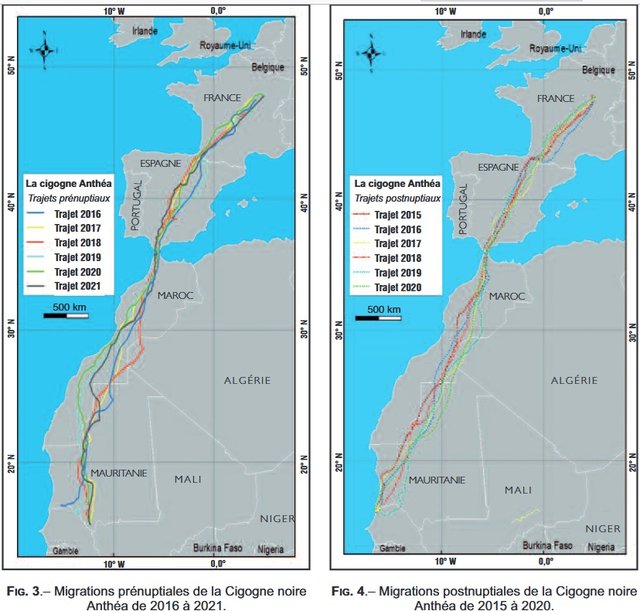Jadoul G, Hourlay F, Toussaint A-C (2003) Suivi de la migration automnale de la Cigogne noire (Ciconia nigra) par télémétrie satellitaire. Aves 40:155–164
Bobek, M., Pojer, F., Peške, L. and Šimek, J. (2003) Wintering of black storks (Ciconia nigra) from the Czech Republic in different parts
of Africa.
Aves, 40: 176-178.
Bobek, M., Pojer, F., Peške, L. and Šimek, J. (2003). African Odyssey Project. Research on the black stork migration and ecology and its
presentation on the Internet.
Aves, 40: 212-221.
Bobek M, Hampl R, Peške L, Pojer F, Šimek J, Bureš S (2008) African Odyssey project - satellite tracking of black storks Ciconia nigra breeding at a migratory divide.
J Avian Biol 39:500–506.
https://doi.org/10.1111/j.0908-8857.2008.04285.x
Chevallier HY, Georges J-Y, Baillon F, Brossault P, Aurouet A, Le Maho Y, Massemin S (2010) Influence of weather conditions on the flight of migrating black storks.
Proc R Soc B Biol Sci 277:2755–2764.
https://doi.org/10.1098/rspb.2010.0422
Chevallier HY, Le Maho Y, Baillon F, Duponnois R, Dieulin C, Brossault P, De Franclieu P, Lorge P, Aurouet A, Massemin S (2010) Human activity and the drying up of rivers determine abundance and spatial distribution of Black Storks Ciconia nigra on their wintering grounds.
Bird Study 57:369–380.
https://doi.org/10.1080/00063651003678467
Chevallier HY, Le Maho Y, Brossault P, Baillon F, Massemin S (2011) The use of stopover sites by Black Storks (Ciconia nigra) migrating between West Europe and West Africa as revealed by satellite telemetry.
J Ornithol 152:1–13.
https://doi.org/10.1007/s10336-010-0536-6
Cano LS, Tellería JL (2013) Migration and winter distribution of Iberian and central European black storks Ciconia nigra moving to Africa across the Strait of Gibraltar: a comparative study.
J Avian Biol 44:189–197.
https://doi.org/10.1111/j.1600-048X.2012.05824.x
Chevallier, D., Baillon, F., Le Maho, Y., Blanc, S., Brossault, P., & Massemin, S. (2013). Importance of the connectivity of Spanish stopovers for Black Storks.
Bird Study, 60(4), 550–554.
https://doi.org/10.1080/00063657.2013.851643
WHITE STORK
Shephard, J.M., Rycken, S., Almalik, O. et al. Migration strategies revealed by satellite tracking among descendants of a population of European white stork (Ciconia ciconia) reintroduced to Belgium.
J Ornithol 156, 943–953 (2015).
https://doi.org/10.1007/s10336-015-1204-7
Andrea Flack et al., Costs of migratory decisions: A comparison across eight white stork populations.
Sci. Adv.2,e1500931(2016). DOI:10.1126/sciadv.15009
Blas, J., Salas, R., Flack, A., Torres-Medina, F., Sergio, F., Wikelski, M., & Fiedler, W. (2020).
Overland and oversea migration of white storks through the water barriers of the straits of Gibraltar. Scientific reports, 10(1), 20760.
https://doi.org/10.1038/s41598-020-77273-x

